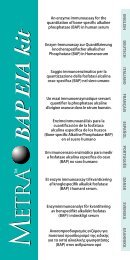PRODUCT INFORMATION AND MANUAL rat VEGF-C ELISA BMS626
PRODUCT INFORMATION AND MANUAL rat VEGF-C ELISA BMS626
PRODUCT INFORMATION AND MANUAL rat VEGF-C ELISA BMS626
Create successful ePaper yourself
Turn your PDF publications into a flip-book with our unique Google optimized e-Paper software.
<strong>PRODUCT</strong> <strong>INFORMATION</strong> <strong>AND</strong> <strong>MANUAL</strong><br />
<strong>rat</strong> <strong>VEGF</strong>-C<br />
<strong>ELISA</strong><br />
<strong>BMS626</strong><br />
Enzyme-linked immunosorbent assay for quantitative<br />
detection of total <strong>rat</strong> Vascular Endothelial Growth<br />
Factor C.<br />
For research use only.<br />
Not for diagnostic or therapeutic procedures.<br />
<strong>rat</strong> <strong>VEGF</strong>-C <strong>ELISA</strong><br />
<strong>BMS626</strong><br />
96 Tests<br />
Bender MedSystems GmbH<br />
Campus Vienna Biocenter 2<br />
A-1030 Vienna, Austria, Europe
TABLE OF CONTENTS<br />
1. INTENDED USE 2<br />
2. SUMMARY 2<br />
3. PRINCIPLES OF THE TEST 3<br />
4. REAGENTS PROVIDED 4<br />
5. STORAGE INSTRUCTIONS 5<br />
6. SPECIMEN COLLECTION 5<br />
7. MATERIALS REQUIRED BUT NOT PROVIDED 6<br />
8. PRECAUTIONS FOR USE 7<br />
9. PREPARATION OF REAGENTS 9<br />
10. TEST PROTOCOL 12<br />
11. CALCULATION OF RESULTS 16<br />
12. LIMITATIONS 19<br />
13. PERFORMANCE CHARACTERISTICS 20<br />
14. BIBLIOGRAPHY 22<br />
15. ORDERING <strong>INFORMATION</strong> 23<br />
17. REAGENT PREPARATION SUMMARY 24<br />
18. TEST PROTOCOL SUMMARY 25<br />
<strong>BMS626</strong> <strong>rat</strong> <strong>VEGF</strong>-C 27.04.06 (06)
1. INTENDED USE<br />
<strong>BMS626</strong> <strong>rat</strong> <strong>VEGF</strong>-C<br />
2<br />
The <strong>VEGF</strong>-C <strong>ELISA</strong> is an enzyme-linked immunosorbent assay for<br />
quantitative detection of total <strong>rat</strong> Vascular Endothelial Growth Factor C<br />
in cell culture supernatants, <strong>rat</strong> serum, plasma, or other body fluids. The<br />
<strong>VEGF</strong>-C <strong>ELISA</strong> is for research use only. Not for use in diagnostic or<br />
therapeutic procedures.<br />
2. SUMMARY<br />
Vascular endothelial growth factor-C (<strong>VEGF</strong>-C) is a member of the<br />
<strong>VEGF</strong> family of cytokines. It has been shown to exhibit angiogenic and<br />
lymphangiogenic actions. The <strong>VEGF</strong> family of growth factors and<br />
receptors is involved in the development and growth of the vascular<br />
endothelial system. Two of its family members, <strong>VEGF</strong>-C and <strong>VEGF</strong>-D,<br />
regulate the lymphatic endothelial cells via their receptor <strong>VEGF</strong>R3, thus<br />
acting as mitogens for these cells.<br />
<strong>VEGF</strong>-C expression is associated with hematological malignancies. Like<br />
<strong>VEGF</strong> it acts as survival factor on leukemia. Together with the<br />
expression of their receptors, <strong>VEGF</strong> and <strong>VEGF</strong>-C result in the<br />
gene<strong>rat</strong>ion of autocrine loops that may support cancer cell survival and<br />
prolife<strong>rat</strong>ion. Further <strong>VEGF</strong>-C expression has been shown in<br />
gastrointestinal tract malignancies where it correlates with lymphatic<br />
invasion, lymphnode metastasis and reduced survival.
3. PRINCIPLES OF THE TEST<br />
An anti-<strong>VEGF</strong>-C polyclonal coating<br />
antibody is adsorbed onto<br />
microwells.<br />
<strong>VEGF</strong>-C present in the sample or<br />
standard binds to antibodies<br />
adsorbed to the microwells; a biotinconjugated<br />
polyclonal <strong>VEGF</strong>-C<br />
antibody is added and binds to<br />
<strong>VEGF</strong>-C captured by the receptors.<br />
Following incubation unbound biotin<br />
conjugated <strong>VEGF</strong>-C is removed<br />
during a wash step. Streptavidin-<br />
HRP is added and binds to the<br />
biotin conjugated <strong>VEGF</strong>-C.<br />
Following incubation unbound<br />
Streptavidin-HRP is removed during<br />
a wash step, and subst<strong>rat</strong>e solution<br />
reactive with HRP is added to the<br />
wells.<br />
A coloured product is formed in<br />
proportion to the amount of<br />
<strong>VEGF</strong>-C present in the sample. The<br />
reaction is terminated by addition of<br />
acid and absorbance is measured at<br />
450 nm. A standard curve is<br />
prepared from seven <strong>VEGF</strong>-C<br />
standard dilutions and <strong>VEGF</strong>-C<br />
sample concent<strong>rat</strong>ion determined.<br />
<strong>BMS626</strong> <strong>rat</strong> <strong>VEGF</strong>-C<br />
3<br />
Coated Microwell<br />
- Polyclonal Coating<br />
First Incubation<br />
- Biotin-Conjugate<br />
- <strong>VEGF</strong>-C<br />
Second Incubation<br />
- Streptavidin-Conjugate<br />
Third Incubation<br />
- Subst<strong>rat</strong>e<br />
- Reacted Subst<strong>rat</strong>e
4. REAGENTS PROVIDED<br />
<strong>BMS626</strong> <strong>rat</strong> <strong>VEGF</strong>-C<br />
4<br />
1 aluminium pouche with a Microwell Plate coated with anti-<strong>VEGF</strong>-C<br />
polyclonal antibody<br />
1 vial (100 µl) Biotin-Conjugate anti-<strong>VEGF</strong>-C polyclonal (goat)<br />
antibody<br />
2 vials <strong>VEGF</strong>-C Standard, 6 ng/ml upon reconstitution<br />
1 vial (150µl) Streptavidin-HRP<br />
1 bottle (12 ml) Sample Diluent (Protein matrix)<br />
1 bottle (50 ml) Wash Buffer Concent<strong>rat</strong>e 20x (PBS with 1% Tween<br />
20)<br />
1 bottle (20 ml) Conjugate Diluent<br />
1 vial (15 ml) Subst<strong>rat</strong>e Solution<br />
1 vial (12 ml) Stop Solution (1M Phosphoric acid)<br />
1 vial (0.4 ml each) Blue-Dye, Green-Dye, Red-Dye<br />
4 adhesive Plate Covers<br />
Reagent Labels
5. STORAGE INSTRUCTIONS<br />
<strong>BMS626</strong> <strong>rat</strong> <strong>VEGF</strong>-C<br />
5<br />
Store kit reagents between 2° and 8°C. Immediately after use remaining<br />
reagents should be returned to cold storage (2° to 8°C). Expiry of the kit<br />
and reagents is stated on labels.<br />
The expiry of the kit components can only be guaranteed if the<br />
components are stored properly, and if, in case of repeated use of one<br />
component, the reagent is not contaminated by the first handling.<br />
6. SPECIMEN COLLECTION<br />
Cell culture supernatants, <strong>rat</strong> serum, EDTA, heparin and cit<strong>rat</strong>e plasma,<br />
and other biological samples will be suitable for use in the assay.<br />
Remove serum from the clot or red cells, respectively, as soon as<br />
possible after clotting and sepa<strong>rat</strong>ion.<br />
Samples containing a visible precipitate must be clarified prior to use in<br />
the assay. Do not use grossly hemolyzed or lipemic specimens.<br />
Samples should be frozen at -20°C, unless they will be assayed the day<br />
of collection. Excessive freeze-thaw cycles should be avoided. Prior<br />
to assay, frozen sera should be brought to room tempe<strong>rat</strong>ure slowly and<br />
mixed gently. Do not thaw samples in a 37°C water bath. Do not vortex<br />
or sharply agitate samples.
7. MATERIALS REQUIRED BUT NOT PROVIDED<br />
- 5 ml and 10 ml graduated pipettes<br />
<strong>BMS626</strong> <strong>rat</strong> <strong>VEGF</strong>-C<br />
6<br />
- 10 µl to 1,000 µl adjustable single channel micropipettes with<br />
disposable tips<br />
- 50 µl to 300 µl adjustable multichannel micropipette with disposable<br />
tips<br />
- Multichannel micropipette reservoir<br />
- Beakers, flasks, cylinders necessary for prepa<strong>rat</strong>ion of reagents<br />
- Device for delivery of wash solution (multichannel wash bottle or<br />
automatic wash system)<br />
- Microwell strip reader capable of reading at 450 nm (620 nm as<br />
optional reference wave length)<br />
- Glass-distilled or deionized water<br />
- Statistical calculator with program to perform linear regression<br />
analysis.
8. PRECAUTIONS FOR USE<br />
<strong>BMS626</strong> <strong>rat</strong> <strong>VEGF</strong>-C<br />
7<br />
- All chemicals should be considered as potentially hazardous. We<br />
therefore recommend that this product is handled only by those<br />
persons who have been trained in labo<strong>rat</strong>ory techniques and that it is<br />
used in accordance with the principles of good labo<strong>rat</strong>ory practice.<br />
Wear suitable protective clothing such as labo<strong>rat</strong>ory overalls, safety<br />
glasses and gloves. Care should be taken to avoid contact with skin<br />
or eyes. In the case of contact with skin or eyes wash immediately<br />
with water. See material safety data sheet(s) and/or safety<br />
statements(s) for specific advice.<br />
- Reagents are intended for research use only and are not for use in<br />
diagnostic or therapeutic procedures.<br />
- Do not mix or substitute reagents with those from other lots or other<br />
sources.<br />
- Do not use kit reagents beyond expi<strong>rat</strong>ion date on label.<br />
- Do not expose kit reagents to strong light during storage or<br />
incubation.<br />
- Do not pipette by mouth.<br />
- Do not eat or smoke in areas where kit reagents or samples are<br />
handled.<br />
- Avoid contact of skin or mucous membranes with kit reagents or<br />
specimens.<br />
- Rubber or disposable latex gloves should be worn while handling kit<br />
reagents or specimens.<br />
- Avoid contact of subst<strong>rat</strong>e solution with oxidizing agents and metal.<br />
- Avoid splashing or gene<strong>rat</strong>ion of aerosols.
<strong>BMS626</strong> <strong>rat</strong> <strong>VEGF</strong>-C<br />
8<br />
- In order to avoid microbial contamination or cross-contamination of<br />
reagents or specimens which may invalidate the test use disposable<br />
pipette tips and/or pipettes.<br />
- Use clean, dedicated reagent trays for dispensing the conjugate and<br />
subst<strong>rat</strong>e reagents.<br />
- Exposure to acids will inactivate the conjugate.<br />
- Glass-distilled water or deionized water must be used for reagent<br />
prepa<strong>rat</strong>ion.<br />
- Subst<strong>rat</strong>e solution must be at room tempe<strong>rat</strong>ure prior to use.<br />
- Decontaminate and dispose specimens and all potentially<br />
contaminated materials as if they could contain infectious agents.<br />
The preferred method of decontamination is autoclaving for a<br />
minimum of 1 hour at 121.5°C.<br />
- Liquid wastes not containing acid and neutralized waste may be<br />
mixed with sodium hypochlorite in volumes such that the final<br />
mixture contains 1.0 % sodium hypochlorite. Allow 30 minutes for<br />
effective decontamination. Liquid waste containing acid must be<br />
neutralized prior to the addition of sodium hypochlorite.
9. PREPARATION OF REAGENTS<br />
<strong>BMS626</strong> <strong>rat</strong> <strong>VEGF</strong>-C<br />
9<br />
Prepare Wash Buffer (reagent A) before starting with the test<br />
procedure.<br />
A. Wash Buffer<br />
If crystals have formed in the Wash Buffer Concent<strong>rat</strong>e, warm it gently<br />
until they have completely dissolved.<br />
Pour entire contents (50 ml) of the Wash Buffer Concent<strong>rat</strong>e into a<br />
clean 1,000 ml graduated cylinder. Bring final volume to 1,000 ml with<br />
glass-distilled or deionized water. Mix gently to avoid foaming. The pH<br />
of the final solution should adjust to 7.4.<br />
Transfer to a clean wash bottle and store at 2° to 25°C. Please note that<br />
the Wash Buffer is stable for 30 days. Wash Buffer may be prepared as<br />
needed according to the following table:<br />
Number Wash Buffer Distilled<br />
of Strips Concent<strong>rat</strong>e (ml) Water (ml)<br />
1 - 6 25 475<br />
1 - 12 50 950<br />
B. Prepa<strong>rat</strong>ion of <strong>VEGF</strong>-C Standard<br />
Reconstitute <strong>VEGF</strong>-C Standard by addition of distilled water.<br />
Reconstitution volume is stated on the label of the standard vial. Mix<br />
gently to ensure complete solubilization. Discard reconstituted Standard<br />
after use.
<strong>BMS626</strong> <strong>rat</strong> <strong>VEGF</strong>-C<br />
10<br />
C. Prepa<strong>rat</strong>ion of Biotin-Conjugate<br />
Dilute the Biotin-Conjugate 1:100 just prior to use with Conjugate<br />
Diluent in a clean plastic tube.<br />
Please note that the Biotin-Conjugate should be used within 30 minutes<br />
after dilution. The dilution (1:100) of the Biotin-Conjugate may be<br />
prepared as needed according to the following table:<br />
Number Biotin-Conjugate Conjugate Diluent<br />
of Strips (ml) (ml)<br />
1 - 6 0.03 3.0<br />
1 - 12 0.06 6.0<br />
D. Prepa<strong>rat</strong>ion of Streptavidin-HRP<br />
Make a 1:400 dilution of the concent<strong>rat</strong>ed Streptavidin-HRP solution as<br />
needed according to the following table:<br />
Number Streptavidin-HRP Conjugate Diluent<br />
of Strips (ml) (ml)<br />
1 - 6 0.015 6.0<br />
1 - 12 0.03 12.0<br />
E. Addition of colour-giving reagents: Blue-Dye, Green-Dye, Red-Dye<br />
In order to help our customers to avoid any mistakes in pipetting the<br />
Bender MedSystems <strong>ELISA</strong>s, Bender MedSystems now offers a new<br />
tool that helps to monitor the addition of even very small volumes of a<br />
solution to the reaction well by giving distinctive colours to each step of<br />
the <strong>ELISA</strong> procedure.<br />
This procedure is optional, does not in any way interfere with the test<br />
results, and is designed to help the customer with the performance of<br />
the test, but can also be omitted, just following the instruction booklet.
<strong>BMS626</strong> <strong>rat</strong> <strong>VEGF</strong>-C<br />
11<br />
Alternatively, the dye solutions from the stocks provided (Blue-Dye,<br />
Green-Dye, Red-Dye) can be added to the reagents according to the<br />
following guidelines:<br />
1. Diluent: Before sample dilution add the Blue-Dye at a<br />
dilution of 1:250 (see table below) to the<br />
appropriate diluent according to the test protocol.<br />
After addition of Blue-Dye, proceed according to<br />
the instruction booklet.<br />
5 ml Sample Diluent 20 µl Blue-Dye<br />
12 ml Sample Diluent 48 µl Blue-Dye<br />
2. Biotin-Conjugate: Before dilution of the concent<strong>rat</strong>ed conjugate,<br />
add the Green-Dye at a dilution of 1:100 (see<br />
table below) to the Conjugate Diluent used for<br />
the final conjugate dilution. Proceed after<br />
addition of Green-Dye according to the<br />
instruction booklet, prepa<strong>rat</strong>ion of Biotinconjugate.<br />
3 ml Conjugate Diluent 30 µl Green-Dye<br />
6 ml Conjugate Diluent 60 µl Green-Dye<br />
3. Streptavidin-HRP: Before dilution of the concent<strong>rat</strong>ed Streptavidin-<br />
HRP; add the Red-Dye at a dilution of 1:250<br />
(see table below) to the Conjugate Diluent used<br />
for the final Streptavidin-HRP dilution. Proceed<br />
after addition of Red-Dye according to the<br />
instruction booklet, prepa<strong>rat</strong>ion of Streptavidin-<br />
HRP.<br />
6 ml Conjugate Diluent 24 µl Red-Dye<br />
12 ml Conjugate Diluent 48 µl Red-Dye
10. TEST PROTOCOL<br />
a. Mix all reagents thoroughly without foaming before use.<br />
<strong>BMS626</strong> <strong>rat</strong> <strong>VEGF</strong>-C<br />
12<br />
b. Determine the number of Microwell Strips required to test the desired<br />
number of samples plus appropriate number of wells needed for<br />
running blanks and standards. Each sample, standard, blank, and<br />
optional control sample should be assayed in duplicate. Remove<br />
extra Microwell Strips coated with anti-<strong>VEGF</strong>-C polyclonal<br />
antibody from holder and store in foil bag with the desiccant<br />
provided at 2°-8°C sealed tightly.<br />
c. Wash the microwell strips twice with approximately 300 µl Wash<br />
Buffer per well with thorough aspi<strong>rat</strong>ion of microwell contents<br />
between washes. Take care not to sc<strong>rat</strong>ch the surface of the<br />
microwells.<br />
After the last wash, empty wells and tap microwell strips on<br />
absorbent pad or paper towel to remove excess Wash Buffer. Use<br />
the microwell strips immediately after washing or place upside down<br />
on a wet absorbent paper for not longer than 15 minutes. Do not<br />
allow wells to dry.<br />
d. Add 100 µl of Sample Diluent in duplicate to all standard wells.<br />
Prepare standard dilutions by pipetting 100 µl of <strong>VEGF</strong>-C Standard,<br />
in duplicate, into well A1 and A2 (see Figure 1 and 2). Mix the<br />
contents of wells A1 and A2 by repeated aspi<strong>rat</strong>ion and ejection, and<br />
transfer 100 µl to well B1 and B2, respectively. Take care not to<br />
sc<strong>rat</strong>ch the inner surface of the microwells. Continue this procedure<br />
five times, creating two rows of <strong>VEGF</strong>-C standard dilutions ranging<br />
from 3000 to 46.9 pg/ml. Discard 100 µl of the contents from the last<br />
microwells (G1, G2) used.
Figure 1. Prepa<strong>rat</strong>ion of <strong>VEGF</strong>-C standard dilutions:<br />
<strong>BMS626</strong> <strong>rat</strong> <strong>VEGF</strong>-C<br />
13<br />
Figure 2. Diagram depicting an example of the arrangement of blanks,<br />
standards and samples in the microwell strips:<br />
1 2 3 4<br />
A Standard 1 Standard 1 Sample 1 Sample 1<br />
(3000 pg/ml) (3000 pg/ml)<br />
B Standard 2 Standard 2 Sample 2 Sample 2<br />
(1500 pg/ml) (1500 pg/ml)<br />
C Standard 3 Standard 3 Sample 3 Sample 3<br />
(750 pg/ml) (750 pg/ml)<br />
D Standard 4 Standard 4 Sample 4 Sample 4<br />
(325 pg/ml) (325 pg/ml)<br />
E Standard 5 Standard 5 Sample 5 Sample 5<br />
(187.5 pg/ml) (187.5 pg/ml)<br />
F Standard 6 Standard 6 Sample 6 Sample 6<br />
(93.75 pg/ml) (93.75 pg/ml)<br />
G Standard 7 Standard 7 Sample 7 Sample 7<br />
(46.9 pg/ml) (46.9 pg/ml)<br />
H Blank Blank Sample 8 Sample 8
e. Add 100 µl of Sample Diluent in duplicate to the blank wells.<br />
f. Add 50 µl of Sample Diluent to the sample wells.<br />
g. Add 50 µl of each Sample, in duplicate, to the designated wells.<br />
h. Prepare Biotin-Conjugate (refer to prepa<strong>rat</strong>ion of reagents 9.C.).<br />
<strong>BMS626</strong> <strong>rat</strong> <strong>VEGF</strong>-C<br />
14<br />
i. Add 50 µl of diluted Biotin-Conjugate to all wells, including the<br />
blank wells.<br />
j. Cover with a Plate Cover and incubate 2 hours at room tempe<strong>rat</strong>ure,<br />
if available on a microplate shaker set at 100 rpm.<br />
k. Remove Plate Cover and empty wells. Wash microwell strips 3 times<br />
according to point c. of the test protocol. Proceed immediately to the<br />
next step.<br />
l. Prepare Streptavidin-HRP (refer to prepa<strong>rat</strong>ion of reagents D).<br />
m. Add 100 µl of diluted Streptavidin-HRP to all wells, including the<br />
blank wells.<br />
n. Cover with a Plate Cover and incubate at room tempe<strong>rat</strong>ure<br />
(18º to 25ºC) for 1 hour, if available on a microplate shaker set at<br />
100 rpm.<br />
o. Remove Plate Cover and empty wells. Wash microwell strips 3 times<br />
according to point c. of the test protocol. Proceed immediately to the<br />
next step.<br />
p. Pipette 100 µl of TMB Subst<strong>rat</strong>e Solution to all wells, including the<br />
blank wells.
<strong>BMS626</strong> <strong>rat</strong> <strong>VEGF</strong>-C<br />
15<br />
q. Incubate the microwell strips at room tempe<strong>rat</strong>ure (18° to 25°C) for<br />
about 10 minutes. Avoid direct exposure to intense light.<br />
The colour development on the plate should be monitored and<br />
the subst<strong>rat</strong>e reaction stopped (see point r. of this protocol)<br />
before positive wells are no longer properly recordable.<br />
It is recommended to add the stop solution when the highest<br />
standard has developed a dark blue colour.<br />
Alternatively the colour development can be monitored by the <strong>ELISA</strong><br />
reader at 620 nm. The subst<strong>rat</strong>e reaction should be stopped as soon<br />
as an OD of 0.6 – 0.65 is reached.<br />
r. Stop the enzyme reaction by quickly pipetting 100 µl of Stop<br />
Solution into each well, including the blank wells. It is important that<br />
the Stop Solution is spread quickly and uniformly throughout the<br />
microwells to completely inactivate the enzyme. Results must be<br />
read immediately after the Stop Solution is added or within one hour<br />
if the microwell strips are stored at 2 - 8°C in the dark.<br />
s. Read absorbance of each microwell on a spectro-photometer using<br />
450 nm as the primary wave length (optionally 620 nm as the<br />
reference wave length; 610 nm to 650 nm is acceptable). Blank the<br />
plate reader according to the manufacturer's instructions by using<br />
the blank wells. Determine the absorbance of both, the samples and<br />
the <strong>VEGF</strong>-C standards.<br />
Note: In case of incubation without shaking the obtained O.D.<br />
values may be lower than indicated below. Nevertheless<br />
the results are still valid.
11. CALCULATION OF RESULTS<br />
<strong>BMS626</strong> <strong>rat</strong> <strong>VEGF</strong>-C<br />
16<br />
- Calculate the average absorbance values for each set of duplicate<br />
standards and samples. Duplicates should be within 20 per cent of<br />
the mean.<br />
- Create a standard curve by plotting the mean absorbance for each<br />
standard concent<strong>rat</strong>ion on the ordinate against the <strong>VEGF</strong>-C<br />
concent<strong>rat</strong>ion on the abscissa. Draw a best fit curve through the<br />
points of the graph.<br />
- To determine the concent<strong>rat</strong>ion of circulating <strong>VEGF</strong>-C for each<br />
sample, first find the mean absorbance value on the ordinate and<br />
extend a horizontal line to the standard curve. At the point of<br />
intersection, extend a vertical line to the abscissa and read the<br />
corresponding <strong>VEGF</strong>-C concent<strong>rat</strong>ion.<br />
- For samples which have been diluted according to the<br />
instructions given in this manual 1:2, the concent<strong>rat</strong>ion has to<br />
be multiplied by the dilution factor (x2).<br />
Note: Calculation of samples with an O.D. exceeding 2.0 may<br />
result in incorrect, low <strong>VEGF</strong>-C levels. Such samples<br />
require further dilution of 1:4 - 1:8 with Sample Diluent in<br />
order to precisely quantitate the actual <strong>VEGF</strong>-C level.<br />
- It is suggested that each testing facility establishes a control sample<br />
of known <strong>VEGF</strong>-C concent<strong>rat</strong>ion and runs this additional control with<br />
each assay. If the values obtained are not within the expected range<br />
of this control, the assay results may be invalid.<br />
- A representative standard curve is shown in Figure 3. This curve<br />
cannot be used to derive test results. Every labo<strong>rat</strong>ory must prepare<br />
a standard curve for each group of microwell strips assayed.
<strong>BMS626</strong> <strong>rat</strong> <strong>VEGF</strong>-C<br />
17<br />
Figure 3. Representative standard curve for <strong>VEGF</strong>-C <strong>ELISA</strong>.<br />
Symbols represent the mean of three parallel tit<strong>rat</strong>ions.<br />
Do not use this standard curve to derive test results. A<br />
standard curve must be run for each group of microwell<br />
strips assayed.<br />
ABSORPTION 450 nm<br />
2.50<br />
2.00<br />
1.50<br />
1.00<br />
0.50<br />
0.00<br />
0 500 1000 1500 2000 2500 3000<br />
<strong>VEGF</strong>-C CONCENTRATION (pg/ml)
<strong>BMS626</strong> <strong>rat</strong> <strong>VEGF</strong>-C<br />
18<br />
Typical data using the <strong>VEGF</strong>-C <strong>ELISA</strong><br />
Measuring wavelength: 450 nm<br />
Reference wavelength: 620 nm<br />
Standard<br />
<strong>VEGF</strong>-C<br />
Concent<strong>rat</strong>ion<br />
(pg/ml)<br />
O.D.<br />
(450 nm)<br />
O.D.<br />
Mean<br />
C.V.<br />
(%)<br />
1 3000 2.147 2.151 0.2<br />
3000 2.155<br />
2 1500 1.283 1.248 2.8<br />
1500 1.213<br />
3 750 0.677 0.701 3.4<br />
750 0.724<br />
4 325 0.388 0.389 0.1<br />
325 0.389<br />
5 187.5 0.220 0.223 1.1<br />
187.5 0.225<br />
6 93.75 0.131 0.136 3.3<br />
93.75 0.140<br />
7 46.9 0.084 0.086 2.3<br />
46.9 0.088<br />
Blank 0 0.041 0.044<br />
0 0.047
12. LIMITATIONS<br />
<strong>BMS626</strong> <strong>rat</strong> <strong>VEGF</strong>-C<br />
19<br />
- Since exact conditions may vary from assay to assay, a standard<br />
curve must be established for every run.<br />
- Bacterial or fungal contamination of either screen samples or<br />
reagents or cross-contamination between reagents may cause<br />
erroneous results.<br />
- Disposable pipette tips, flasks or glassware are preferred, reusable<br />
glassware must be washed and thoroughly rinsed of all detergents<br />
before use.<br />
- Improper or insufficient washing at any stage of the procedure will<br />
result in either false positive or false negative results. Completely<br />
empty wells before dispensing fresh Wash Buffer, fill with Wash<br />
Buffer as indicated for each wash cycle and do not allow wells to sit<br />
uncovered or dry for extended periods.<br />
- Excessive freeze – thaw cycles may result in loss of bio-active<br />
<strong>VEGF</strong>-C. Avoid repeated freeze – thaw cycles, preferentially use<br />
freshly collected samples.
<strong>BMS626</strong> <strong>rat</strong> <strong>VEGF</strong>-C<br />
20<br />
13. PERFORMANCE CHARACTERISTICS<br />
A. Sensitivity<br />
The limit of detection of <strong>VEGF</strong>-C defined as the analyte concent<strong>rat</strong>ion<br />
resulting in an absorption significantly higher than that of the dilution<br />
medium (mean plus two standard deviations) was determined to be 3.7<br />
pg/ml (mean of 6 independent assays).<br />
B. Reproducibility<br />
a. Intra-assay<br />
Reproducibility within the assay was evaluated in independent<br />
experiments. The overall intra-assay coefficient of variation has been<br />
calculated to be
E. Sample Stability<br />
a. Freeze-Thaw Stability<br />
<strong>BMS626</strong> <strong>rat</strong> <strong>VEGF</strong>-C<br />
21<br />
Aliquots of spiked serum were stored at -20°C and thawed up to 5<br />
times, and <strong>VEGF</strong>-C levels determined. There was no significant loss of<br />
<strong>VEGF</strong>-C by repeated freezing and thawing.<br />
b. Storage Stability<br />
Aliquots of spiked serum were stored at -20°C, 2-8°C, room<br />
tempe<strong>rat</strong>ure (RT) and at 37°C, and the <strong>VEGF</strong>-C level determined after<br />
24 h. There was no significant loss of <strong>VEGF</strong>-C immunoreactivity during<br />
storage under above conditions.<br />
F. Specificity<br />
The interference of circulating factors of the immune systems was<br />
evaluated by spiking these proteins at physiologically relevant<br />
concent<strong>rat</strong>ions into a <strong>VEGF</strong>-C positive serum. There was no<br />
interference with any of the spiked proteins.
14. BIBLIOGRAPHY<br />
<strong>BMS626</strong> <strong>rat</strong> <strong>VEGF</strong>-C<br />
22<br />
1) Clauss M. Molecular biology of the <strong>VEGF</strong> and the <strong>VEGF</strong> receptor<br />
family.<br />
Semin Thromb Hemost. 2000; 26 (5): 561-9.<br />
2) Duff SE, Li C, Jeziorska M, Kumar S, Saunders MP, Sherlock D,<br />
O’Dwyer ST, Jayson GC. Vascular endothelial growth factors C and<br />
D and lymphangiogenesis in gastrointestinal tract maligancy.<br />
Br J Cancer. 2003 Aug 4; 89 (3): 426-30.<br />
3) Ferrara N. Vascular endothelial growth factor and the regulation of<br />
angiogenesis.<br />
Recent Prog Horm Res. 2000; 55: 15-35; discussion 35-6.<br />
4) Jussila L, Alitalo K. Vascular growth factors and lymphagiogenesis.<br />
Physiol Rev. 2002 Jul; 82 (3): 673-700.<br />
5) Karkkainen MJ, Petrova TV. Vascular endothelial growth factor<br />
receptors in the regulation of angiogenesis and lymphangiogenesis.<br />
Oncogene. 2000 Nov. 20; 19 (49): 5598-605.<br />
6) Larrivee B, Karsan A. Signaling pathways induced by vascular<br />
endothelial growth factor (review).<br />
Int J Mol Med. 2000 May; 5 (5): 447-56.<br />
7) Olofsson B, Jeltsch M, Eriksson U, Alitalo K. Current biology of<br />
<strong>VEGF</strong>-B and <strong>VEGF</strong>-C.<br />
Curr Opin Biotechnol. 1999 Dec; 10 (6): 528-35.<br />
8) Orpana A, Salven P. Angiogenic and lymphangiogenic molecules in<br />
hematological malignancies.<br />
Leuk Lymphoma. 2002 Feb; 43 (2): 219-24.<br />
9) Pepper MS. Lymphangiogenesis and tumor metastasis: myth or<br />
reality? Clin Cancer Res. 2001 Mar; 7 (3): 462-8.<br />
For lite<strong>rat</strong>ure update refer to www.bendermedsystems.com/44.html
15. ORDERING <strong>INFORMATION</strong><br />
For orders please contact:<br />
<strong>BMS626</strong> <strong>rat</strong> <strong>VEGF</strong>-C<br />
23<br />
Europe-Headquarters<br />
Bender MedSystems GmbH<br />
Campus Vienna Biocenter 2<br />
A-1030 Vienna, Austria, Europe<br />
phone: +43 1 796 40 40 ext. 114<br />
fax: +43 1 796 40 40 ext. 400<br />
e-mail: order@bendermedsystems.com<br />
USA<br />
Bender MedSystems, Inc.<br />
849 Hinckley Road<br />
Burlingame, CA 94010, USA<br />
toll-free phone: +1 (866) 952 2112<br />
toll-free fax: +1 (877) 952 2112<br />
phone: +1 (650) 952 2112<br />
fax: +1 (650) 952 2252<br />
For technical information please contact:<br />
e-mail: techserv@bendermedsystems.com<br />
www.bendermedsystems.com<br />
Cat.No. <strong>BMS626</strong> <strong>rat</strong> <strong>VEGF</strong>-C <strong>ELISA</strong>
<strong>BMS626</strong> <strong>rat</strong> <strong>VEGF</strong>-C<br />
24<br />
17. REAGENT PREPARATION SUMMARY<br />
A. Wash Buffer Add Wash Buffer Concent<strong>rat</strong>e 20 x (50 ml) to<br />
950 ml distilled water<br />
B. Standard Reconstitute Standard by addition of distilled<br />
water. Reconstitution volume is stated on label of<br />
the standard vial.<br />
C. Biotin-Conjugate Make a 1:100 dilution according to the table.<br />
Number Biotin-Conjugate Conjugate<br />
Diluent<br />
of Strips (ml) (ml)<br />
1 - 6 0.03 3.0<br />
1 - 12 0.06 6.0<br />
D. Streptavidin-HRP Number Streptavidin-HRP Conjugate<br />
Diluent<br />
of Strips (ml) (ml)<br />
1 - 6 0.015 6.0<br />
1 - 12 0.03 12.0
18. TEST PROTOCOL SUMMARY<br />
<strong>BMS626</strong> <strong>rat</strong> <strong>VEGF</strong>-C<br />
25<br />
- Wash microwell strips twice with Wash Buffer<br />
- Add 100 µl Sample Diluent, in duplicate, to standard wells<br />
- Pipette 100 µl <strong>VEGF</strong>-C Standard into the first wells and create<br />
standard dilutions ranging from 3000 to 46.9 pg/ml by transferring<br />
100 µl from well to well. Discard 100 µl from the last wells<br />
- Add 100 µl Sample Diluent, in duplicate, to the blank wells<br />
- Add 50 µl Sample Diluent to sample wells.<br />
- Add 50 µl Sample, in duplicate, to designated wells<br />
- Prepare Biotin-Conjugate<br />
- Add 50 µl of diluted Biotin-Conjugate to all wells<br />
- Cover microwell strips and incubate 2 hours at room tempe<strong>rat</strong>ure on<br />
a microplate shaker set at 100 rpm<br />
- Prepare Streptavidin-HRP<br />
- Empty and wash microwell strips 3 times with Wash Buffer<br />
- Add 100 µl diluted Streptavidin-HRP to all wells<br />
- Cover microwell strips and incubate 1 hour at room tempe<strong>rat</strong>ure<br />
(18º to 25ºC) on a microplate shaker set at 100 rpm<br />
- Empty and wash microwell strips 3 times with Wash Buffer<br />
- Add 100 µl of TMB Subst<strong>rat</strong>e Solution to all wells including blank<br />
wells<br />
- Incubate the microwell strips for about 10 minutes at room<br />
tempe<strong>rat</strong>ure (18°to 25°C)<br />
- Add 100 µl Stop Solution to all wells including blank wells<br />
- Blank microwell reader and measure colour intensity at 450 nm<br />
-<br />
Note: Calculation of samples with an O.D. exceeding 2.0 may<br />
result in incorrect, low <strong>VEGF</strong>-C levels. Such samples<br />
require further dilution of 1:4 - 1:8 with Sample Diluent in<br />
order to precisely quantitate the actual <strong>VEGF</strong>-C level.


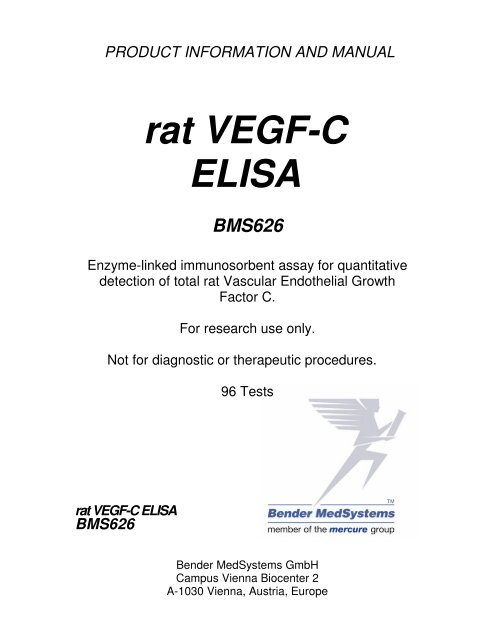
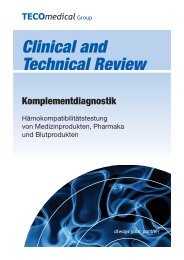
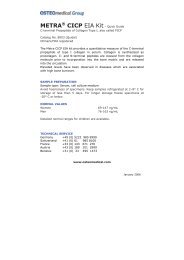
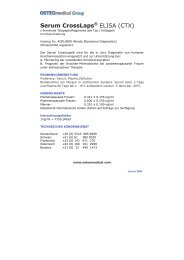
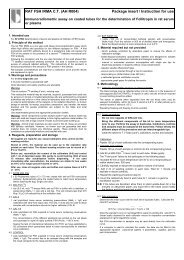


![PTH [Hormone Parathyroïdienne] Intacte ELISA](https://img.yumpu.com/1233682/1/190x245/pth-hormone-parathyroidienne-intacte-elisa.jpg?quality=85)
